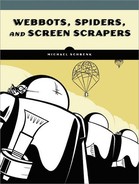Parsing is the process of segregating what's desired or useful from what is not. In the case of webbots, parsing involves detecting and separating image names and addresses, key phrases, hyper-references, and other information of interest to your webbot. For example, if you are writing a spider that follows links on web pages, you will have to separate these links from the rest of the HTML. Similarly, if you write a webbot to download all the images from a web page, you will have to write parsing routines that identify all the references to image files.
One of the problems you'll encounter when parsing web pages is poorly written HTML. A large amount of HTML is machine generated and shows little regard for human readability, and hand-written HTML often disregards standards by ignoring closing tags or misusing quotes around values. Browsers may correctly render web pages that have substandard HTML, but poorly written HTML interferes with your webbot's ability to parse web pages.
Fortunately, a software library known as HTMLTidy[14] will clean up poorly written web pages. PHP includes HTMLTidy in its standard distributions, so you should have no problem getting it running on your computer. Installing HTMLTidy (also known as just Tidy) should be similar to installing cURL. Complete installation instructions are available at the PHP website.[15]
The parse functions (described next) rely on Tidy to put unparsed source code into a known state, with known delimiters and known closing tags of known case.
Note
If you do not have HTMLTidy installed on your computer, the parsing described in this book may not work correctly.
